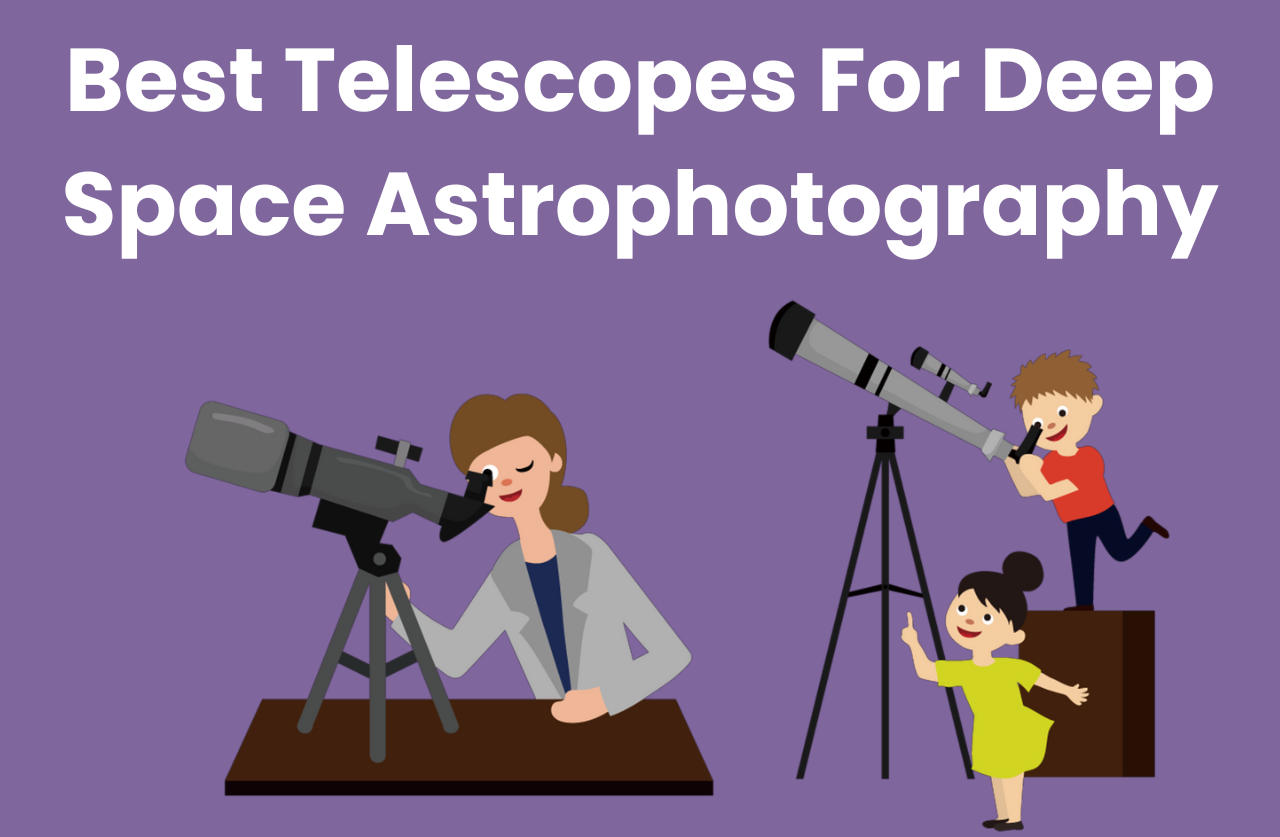
Seeing the deep sky object is not as easy as you think. Nevertheless, it becomes better when you use a telescope. With a telescope, you’ll see things that are absolutely impossible to view with visual astronomy.
You can’t use any telescope to see deep sky objects. That means there are telescopes specifically designed for deep space astrophotography. We’ve tried practically all the telescopes designed for deep space astrophotography, but we’ve found these three to be the best.
Best Telescopes for Deep Space Astrophotography
1. Celestron NexStar 8SE Telescope
The Celestron NexStar 8SE Telescope is a Schmidt-Cassegrain type with 8-inch wide aperture that is powerful enough to gather all the light needed for compelling deep space viewing. Although the scope’s focal ratio is too long at f/10, its magnifying power is fantastic. Its star diagonal image production means your image will come out perfectly.
The presence of a finderscope and computerized GO TO mount also means you can never miss anything while gazing vigorously into the sky. Despite that, the scope is affordable, light, and portable enough for you to make a travel companion. Both experienced and rookies can also use it.
However, the telescope is unsuitable for long use as the battery life is very short. Apart from that, its plastic construction makes it less sturdy. But, of course, the two years warranty on the product means you have nothing to fear concerning the quality.
What we like
Excellent magnifying power
Light and portable
Computerized GO TO mount
Backed by a 2-years warranty
What we don’t like
Too long focal ratio
Short battery lifespan
2. Tele Vue NP127 Telescope
The Tele Vue NP127 Telescope is definitely what you will love for your deep space astrophotography. It is a refractor telescope with 5-inch wide aperture. This, of course, can go as deep as you want.
At f/5.2, the telescope is fast and allows quick transition from imaging to viewing. That’s not all! Thanks to the fully coated optics, you can also count on the telescope for brighter and high-contrast images.
Its ability to deliver a bright, high-contrast image makes it very easy to view deep sky objects without any hitch. It doesn’t end there! The telescope comes with good accessories. Some of them are:
- Hard shell carrying case for easy transportation
- Imaging insert ring with four lock screws for attachment,
- Sliding metal dew shield and screw-on metal lens cover which combines to protect the telescope for emergency damage.
Another plus is that a solid 5-year warranty backs the telescope. That should tell you that there is nothing substandard about the scope.
What we like
Easy to transport
Backed by a 5-years warranty
Bright and high-contrast image
It comes with good accessories
What we don’t like
It doesn’t come with a finder scope
Relatively short aperture
3. Explore Scientific AR127 Telescope
This is yet another fantastic doublet achromatic refractor you can trust for effective deep space astrophotography. The telescope combines everything possible to improve your deep sky gazing experience.
Foremost, there is a 2″ dual-speed focuser and one-piece 2″ diagonal with 99% dielectric coatings. These duo synergies to give you an impactful image.
Also, you will find a finderscope in it, and the aperture is wide enough to gather all light needed for an amazing deep sky viewing. When purchasing the telescope, you will get a focal tube cap and an objective lens cap. That’s weird, isn’t it?
The telescope doesn’t come with a mount. That means you must create a separate mount budget once you purchase it. That’s not fair to be candid. Anyway, it has a mount plate that can support either the alt-azimuth or equatorial mount of your choice.
What we like
Comes with finderscope
Compatible with an alt-azimuth mount
Has dual-speed focuser
What we don’t like
It doesn’t come with a mount
Narrow field of view
How to Choose a Telescope for Deep Space Astrophotography
Are you new to deep space astrophotography and need to buy a suitable telescope for it? Or perhaps you are an experienced deep space astrophotographer and planning to replace your old telescope but don’t know how to choose it?
Here are simple tips for choosing a telescope for deep space astrophotography.
Type of Telescope
The most common types of telescopes used in deep space astrophotography are reflectors and refractors. The reflector telescope uses mirror to gather light for image formation, unlike the refractor that uses lenses for image formation.
If you like reflector telescopes, you can use the simple Newtonian reflector instead of the Dobsonian reflector. For refractors, both achromatic and apochromatic can be used. But, the apochromatic type will do the job better.
Focal Ratio
The focal ratio is another essential thing to consider while stocking for a telescope for deep space astrophotography. The focal ratio is usually expressed in f/n. And it shows the time taken for telescope to deliver set amount of light. Generally, the lower the focal ratio, the more precise the image.
For deep space astrophotography, go for a telescope with a focal ratio that is not too short or long. Generally, one with f/4 or f/5 will suffice.
Aperture size
The size of the aperture determines the amount of light that enters your telescope. So, the larger the aperture size, the better the image and the bulky the scope. For deep space astrophotography, go for a scope with a wide aperture, preferably 5 to 8 inches. This size will reveal all the necessary details about any deep sky object without weighing you down.
Mount
Mount is as important as the optic part of your telescope. Not all mounts are suitable for deep space astrophotography. Generally, the equatorial mount is the best for deep space astrophotography. With this mount, you can quickly locate your target. Besides, you can take the long-exposure image with the mount.
Accessories
Most telescopes come with accessories, but not all come with good accessories. Ensure you pick a telescope that comes with good accessories. Some accessories you should look out for are a carrying case, finderscope, and lens cover, to mention a few.
Frequently Asked Questions
How much does a deep space telescope cost?
As a whole, the cost of a deep space telescope ranges between $800 and $3,000. However, the price of the telescope still depends on the brand, technology, number of accessories that arrive with the telescope, optical design, and lots more.
For instance, a telescope from a reputable brand is expected to be pricier than one from an unknown brand. Also, the number of accessories in a telescope varies, and you should expect a telescope with higher number of accessories to be pricier than one with less.
What are the easiest objects to see in deep space astrophotography?
Deep space astrophotography entails capturing of objects beyond the solar system. These objects are galaxies, clusters of stars, and nebulae. So, the easiest objects you can see in the deep space astrophotography are dusts, star clusters, galaxies, and nebulae.
How big of a telescope do you need to see galaxies?
Of course the size of the telescope really matters when viewing the galaxy. This is due to the small and faint appearance of galaxy. So, to view galaxy, you need a telescope with wide aperture, preferably 8 inch wide.
How do I view deep sky objects with a telescope?
Once you’ve gotten a telescope that is 5 – 8 inch wide, viewing deep sky objects will become a bit fun. However, deep sky objects are not view the same way. That is, the way you view galaxies is relatively different from how you view star cluster. You can view galaxies using any of the following method.
- Study the shape:. To do this, start increasing the magnification of your scope until you get the galaxy’s shape. You can the higher power of the eyepiece for that. Usually, galaxies occur in different shapes. The most common ones are round, oval, rectangular, and triangular
- Utilize the filter: Galaxies are known for their ability to emit light. And the light can cause you to lose focus while viewing it. So, a filter will help eliminate the light emitted by the galaxy so you can have better grasp of it.
Bottom Line
The kind of telescope you use will go a long way to determining if you can see deep space object or not. While buying microscope for deep space astrophotography, go for the known brand. And ensure it has good optical features like wide aperture (5- 8 inch), and short focal ratio.
Fortunately, the three telescope reviewed in this post has wide aperture, and they are made from reputable brand. So, the choice is yours to pick any one from the three.
